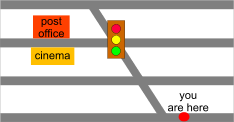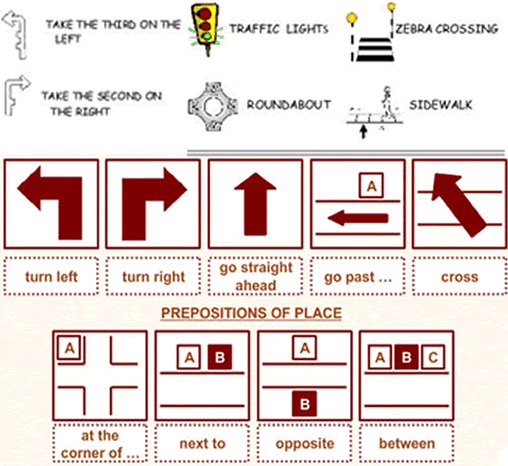Preposition of Place
|
Prepositions of location
|
useful expressions to give directions
| |||||
Outside/inside
|
in back of / Behind
|
How do I get to the police station?
|
Can you tell me where the police station is?
| |||
Far from / near(by)
|
In, on, at
| |||||
In front of
|
across from/ opposite
|
Walk / go up/down for two blocks until/to…
| ||||
go straight ahead (for one block)
| ||||||
Straight ahead
|
to the right of
|
Go to the end of the (next) block …
| ||||
It’s about 50 meters from here.
|
It’s in the middle of the block.
| |||||
Take the first street on the left.
|
It’s on the right/left
|
Cross …/ It’s crossing
| ||||
on/at the corner of …and …
|
to the left of
|
turn (to the) right/left
|
make a right/left
| |||
Next to
|
near
|
It’s over here/there
|
It’s close to the street
| |||
Observe the map and choose the correct preposition.

1. The music store is Santos Dumont Street and Rosa e Silva Avenue.
2. The hospital is the pet shop.
3. The toy store is the music store and the restaurant.
4. The supermarket is the restaurant.
5. The fast food restaurant is Amélia Street.
6. The bookstore is the supermarket.
7. The bank is on Santos Dumont Street the flower shop.
8. The school is Amélia Street and Rosa e Silva Avanue.
9. The pet shop is Amélia Street.

What's the best way to the post office? (Use the map for orientation.)
- Excuse me, where is the post office, please?
- at the next corner.
- Then until you come to the traffic lights.
- there.
- The post office is the cinema.



Exercises on giving directions and locations
There is and there are exercises
Exercises on there is and there are:
 |
Excuse me!
Where is … McDonalds
Excuse me
how do I get to …
Excuse me I
am looking for …
How to give
directions
1. Go + (right / left / down
/ up / straight).
2. Take + (your right /your
left / road name).
3. Turn + right / left
4. Stay on + road name + for
half an hour (distance or time)
Use
transition words like:
1.
After that (take
Brazil Avenue)
2.
Then ((you)turn
right)
3.
Next (you will
see a super market, Saga Flabella, a church)
4.
When you get
to (the church) down the hill /up the slope )
5.
Finally ( you will
see the house)
Use Landmarks:
v A red building on your right.
v Across McDonalds
v Diagonally opposite to the Police station
Warnings:
v It’s a very busy road.
v It’s a one way lane.
v There might be …
|

Word List
- Asking for and Giving Directions
- How do I get to …?
- What's the best way to …?
- Where is …?
- Go straight on (until you come to …).
- Turn back./Go back.
- Turn left/right (into …-street).
- Go along …
- Cross …
- Take the first/second road on the left/right
- It's on the left/right.
- straight [streɪt] on
- opposite ['ɒpəzɪt]
- near [nɪə]
- next to
- between [bɪ'twiːn]
- at the end (of)
- on/at the corner
- behind [bɪ'hʌɪnd]
- in front of
- (just) around the corner
- traffic lights
- crossroads, junction [ʤʌŋ(k)ʃ(ə)n]
- signpost ['sʌɪnpəʊst]
- How to Give Directions
 You know how to ASK for directions, but what happens when an English speaker asks YOU for directions. This is not a time for small talk. Give only basic directions with short phrases. Do the best you can.
You know how to ASK for directions, but what happens when an English speaker asks YOU for directions. This is not a time for small talk. Give only basic directions with short phrases. Do the best you can.
Questions you may hear
How do I get to Main Street?
Where is the closest gas station?
Can you tell me where the community centre is?
I’m looking for Jane Street.
Are you from around here?
If you know the way…
Use basic English to offer directions. Short phrases are best. Speak slowly and use very careful pronunciation. Spell out a word if necessary.
The easiest way is to…
The quickest way is to…
The best way is to…
go + direction (right, left, down, up, through)
take + road name
turn + right/left
stay on + road name for + distance or time
Examples:
The easiest way is to go right on Commercial Avenue.
The quickest way is to take Road Number 1.
The best way is to turn right on Main Street.
Stay on Route 1 for about ten minutes.
Use transitions
Separate each leg of the route with a transition.
after that
then
next
when you get to…go…
finally
Offer “Ballpark Figures” (rough estimates of time or length of travel)
Some people feel better knowing how long it will take to get from A to B.
It’s just around the corner (not far).
It’s not far.
It’s a bit of a way. (it takes a while)
It’s about a five minute walk.
It’s about a twenty minute bus ride.
Use landmarks
Tell the person what to watch for.
You will see a large clock on the right.
You will pass a gas station.
It’s across from the blue church.
More useful language
It’s on + street name
It’s across from
It’s opposite
It’s near
It’s around the corner from
Offer warnings
Stay in the right lane.
It’s a very busy road.
It’s a big hill. (if they are walking or on a bike)
There might be construction.
If you pass the … you went too far.
There’s no parking.
Repeat yourself
If YOU repeat the directions again, the other person will feel more confident. Repeat important details including street names and turns. You can also ask the other person to repeat the directions back to you.
If you are in the car with the driver…
Give a lot of warning.
Turn right at the next street
Get in the left lane.
Go one more block. Then turn right.
At the next traffic lights turn…
It’s going to be on your right.
Clarify
Make sure that the other person understood your directions. Say: “Did you get all that?”
If you don’t know the way…
Don’t guess! Don’t just shake your head and walk away. Use one of these phrases:
I’m sorry, I’m not from here.
I’m afraid I can’t help you.
Sorry I don’t know my way around here.
Offer another solution
You could ask the bus driver.
Ask the front desk clerk.
Follow me. I’ll show you the way.
Do you want me to draw you a map?




No comments:
Post a Comment